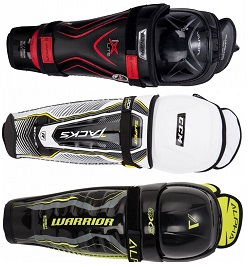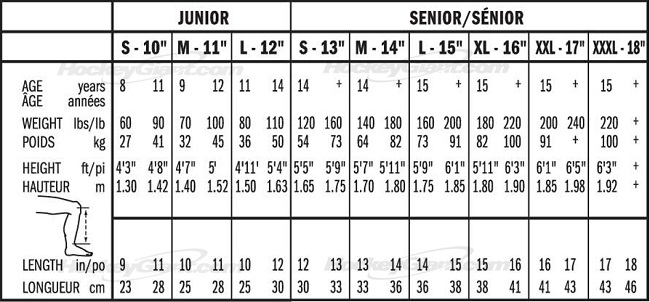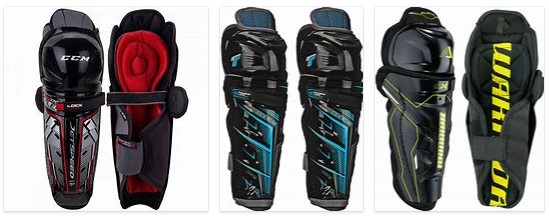
Why do you need Shin Guards for Hockey?
Shin guards are primarily designed to protect your shins from pucks and hockey sticks (hacks and slashes) and protect your knees from the ice when you fall. Mid and high-end models also protect your calves. If you are just getting started in hockey you may not NEED to wear shin pads (for stick and puck and pond hockey), but I do recommend them!
Popular brands
The most common brands are:
- Bauer (Supreme, Vapor, Nexus)
- CCM (Super Tacks, Jetspeed)
- Warrior (Dynasty, Alpha)
- Sher-Wood, Winnwell Graf, and Powertek are also around, although not as common.
- Reebok (Now under the CCM name)
- Easton (now owned by Bauer – Stealth, Mako)
Difference in material / features among price ranges
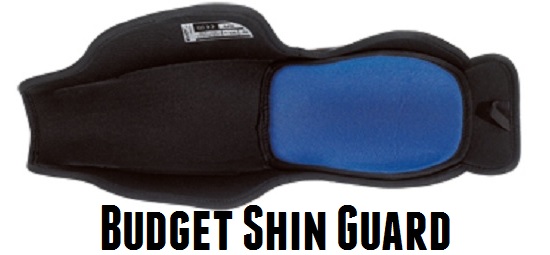
The common feature shared by all shin guards is that they are comprised of a plastic outer shell, and a foam liner. The plastic shell has two parts with the joint just under the knee, which enables more flexibility and a better fit.
The very cheapest shin guards have a fairly thin shell and liner, making them far less protective. As you start to increase quality, you will get a thicker shell, more padding, and higher quality materials. You also get a more substantial calf wrap, which can be useful. High-end pads often use different types of foam to supplement the usual ones, such as Bauer’s Armor foam or Poron XRD (which is actually pretty neat), or CCM’s D30 foam. These materials allow for very high levels of protection without becoming excessively heavy.

Shin Pad Sizing & Fit
The most important aspect of fit is the length. Shin guards are measured in inches (usually whole), which indicates the distance from the middle of the plastic knee shell down to the bottom of the shin shell.
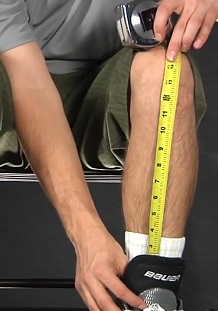 If you are measuring yourself to find your shin pad size simply measure your leg in the same way you would measure the shin pad itself. Start in the middle of your knee bone, and go down to the top of your ankle bone. The measurement you get in inches should be the same as the shin pad size you need.
If you are measuring yourself to find your shin pad size simply measure your leg in the same way you would measure the shin pad itself. Start in the middle of your knee bone, and go down to the top of your ankle bone. The measurement you get in inches should be the same as the shin pad size you need.
Each manufacturer also has a rule-of-thumb sizing chart (using your height to determine shin guard size), but measuring yourself will be more precise, since even two people of the same height can have different size legs.
The best way to find out what fits you is to simply try a bunch on. When you stand up with knees slightly bent, the shin pad should comfortably cover your knee, and go down to just slightly above your ankle bone. You should be able to fit 2 or 3 fingers horizontally underneath the bottom of the shin guard, at the front. Ideally you should be able to tighten the shin pads up well enough that they won’t rotate, but sock tape can also help if needed (see personal preferences).
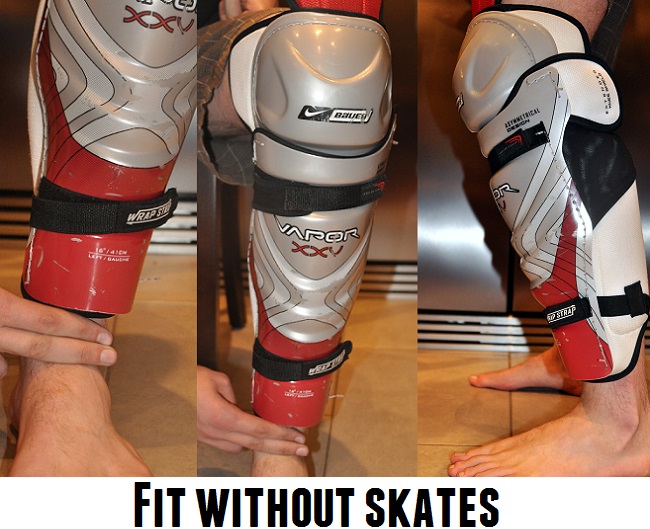
This shows the fit without skates, the extra space between the bottom of the shin guard and the foot leaves room to lace up the skates.
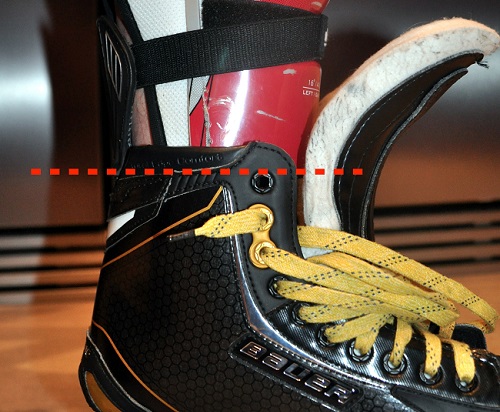
The red line shows where the shin guard ends. For extra protection you can get a slightly longer shin pad and put it over the tongue of the skate.
Common personal preferences for Shin Guards
When it comes to shin guards there are a few different preferences. When buying you can go with a tight fit, or a loose fit. When wearing them you can tuck them over the tongue of your skate, put the tongue between the shin guard and sock, or let the tongue flop out. There is also a preference for how you tape them
Tight or Loose
If you like a tight fit, or just feel your current shin guards are too loose, you can use shin pad tape (also called sock tape or – in the dressing room – simply “clear”). It comes in a variety of colors (most commonly clear), and has a plastic, slightly elastic feel to it. Almost every hockey player uses clear tape on their socks to help secure their shin pads. I’ve got nice fitting shin pads with velcro that holds them in place so I don’t use sock tape.
Tuck or Flop?
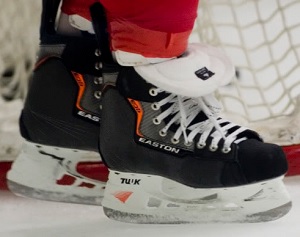 You will need to choose whether you want to tuck your shin pad underneath your skate’s tongue, or put it over top. Putting it over allows you to have a slightly longer shin guard (and slightly more protective coverage as a result), but can also make it more difficult to move your ankle. Forwards are more likely to tuck in their shin pad compared to defensemen (better to have it outside for blocking shots), although in the end it is a highly personal preference. Whichever your decision, you should keep it in mind when buying your shin guards. Shin guards which are wider at the ankle are easier to put over top, and vice versa.
You will need to choose whether you want to tuck your shin pad underneath your skate’s tongue, or put it over top. Putting it over allows you to have a slightly longer shin guard (and slightly more protective coverage as a result), but can also make it more difficult to move your ankle. Forwards are more likely to tuck in their shin pad compared to defensemen (better to have it outside for blocking shots), although in the end it is a highly personal preference. Whichever your decision, you should keep it in mind when buying your shin guards. Shin guards which are wider at the ankle are easier to put over top, and vice versa.
Expected Shin Pad lifetime, general care & maintenance
A good set of shin guards can easily last 5+ years of heavy use with proper care. As with most other equipment, an Under Armor-type base layer will help extend its lifespan. Setting your equipment out to dry immediately after playing will also make a huge difference.
Shin guards are pretty low-maintenance. If it has a removable lining, consider washing it occasionally, especially if you don’t wear a base layer.
Check the plastic shell for cracks once in a while. Although they won’t fall apart overnight, sometimes a particularly hard impact can start spiderweb cracks and result in something that won’t protect you properly.
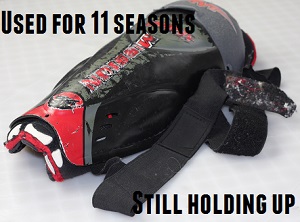 note from coach Jeremy: I bought a decent pair of shin pads when I was 17, I am now 28 and still wear the same ones. I have been playing a few times a week from September to March. I air out my shin guards after (almost) every skate, and toss them in the wash machine with my stinky gear every month or so. The only thing that is starting to wear is a bit of fabric and the Velcro (which I replaced with a new Velcro using a needle and thread)
note from coach Jeremy: I bought a decent pair of shin pads when I was 17, I am now 28 and still wear the same ones. I have been playing a few times a week from September to March. I air out my shin guards after (almost) every skate, and toss them in the wash machine with my stinky gear every month or so. The only thing that is starting to wear is a bit of fabric and the Velcro (which I replaced with a new Velcro using a needle and thread)
Recommendations When Buying Shin Pads
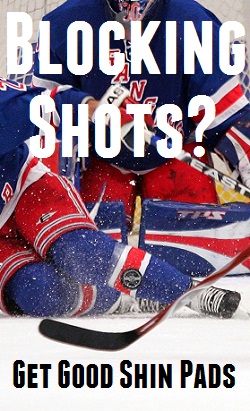 Generally speaking, the cheapest shin guards are usually inadequate for anything except light slashes. Even falling on your knee will still hurt – they just aren’t thick enough. At the very least, look for something with a removable liner. These usually start at around $50-$70 depending on the brand.
Generally speaking, the cheapest shin guards are usually inadequate for anything except light slashes. Even falling on your knee will still hurt – they just aren’t thick enough. At the very least, look for something with a removable liner. These usually start at around $50-$70 depending on the brand.
If you spend a lot of time in front of the net, you should probably find something with a good calf wrap. Getting hit by a puck in the meaty part of your calf can really hurt, and will leave a nasty bruise. Same thing if you play with guys that like to hack and slash a lot.
Finding the right size
Getting the right fit is very important. One of the most painful spots (and most common spot) to get hit with a puck is right where the shin guard meets the skate. A proper fit leaves very little room here, but if your shin guards are too short it will leave a bigger gap there, and you WILL get hit there, and it WILL hurt. Save yourself some pain and make sure your shin guards fit properly.
Should I buy used Shin Guards for Hockey?
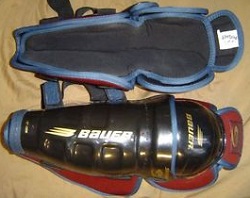 Depending on your area, you may be able to find used shin guards. As long as they are in good condition, there isn’t really any downside. Just make sure you inspect them before you buy. Check to make sure the shell and liner aren’t damaged, and that the Velcro on the straps is still functional (unless you just want to use tape).
Depending on your area, you may be able to find used shin guards. As long as they are in good condition, there isn’t really any downside. Just make sure you inspect them before you buy. Check to make sure the shell and liner aren’t damaged, and that the Velcro on the straps is still functional (unless you just want to use tape).

